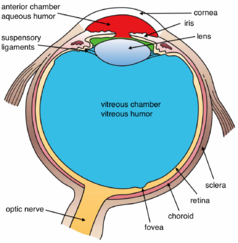Eye Muscle Exercise
This article or area is currently under construction and may only be partially complete. Please come back soon to see the finished work! (Template:28/Template:5/Template:2020)
Introduction[edit | edit source]
The eye divided into three layers; the outermost layer is a fibrous layer and it is consists of the cornea that is transparent located at the center of the eye, the sclera is white and covers the rest of the eye. The second layer is a vascular layer it is consists of the choroid (contain blood supply to the retina), the iris (contains pupils and smooth muscles that controls its diameter[1]), and the ciliary body which is a tissue extends from the sclera and attaches to the lens via suspensory ligament. The inner layer and it contains the retina.
The extraocular muscles are seven muscles supplied by cranial nerves that are responsible for eye movement, in some cases when these nerves are affected consequently they affect eye movements, autoimmune diseases such as myasthenia gravis, improve vision, or strength eye muscles.
Eye Muscles[edit | edit source]
The ocular movement occurs around the three axis[2]:
- Adduction (medial pupil movement toward nose)/ Abduction (lateral pupil movement) around the vertical axis.
- Elevation (superior movement)/ Depression (inferior movement) around the transverse axis.
- Intorsion/ Extorsion (the movement away and toward nose) that we need during tilting the head around the anteroposterior axis
The seven muscles of extraocular muscles divided into 4 recti, 2 obliques muscles, and one levator palpebrae superiors that is responsible for elevation of the superior eyelid.
| Muscle | Origin | Insertion | Nerve supply | Action |
|---|---|---|---|---|
| Superior rectus | common tendinous ring | superior and anterior aspect of sclera | oculomotor nerve (cranial nerve III) | elevation and contributes to adduction and intorsion |
| Inferior rectus | inferior and anterior aspect of sclera | depression and contributes to adduction and extorsion | ||
| Medial rectus | medial aspect of sclera | adducts eye | ||
| Lateral rectus | lateral aspect of sclera | abducens nerve (cranial nerve VI) | abducts eye | |
| Superior oblique | body of sphenoid bone | at sclera posterior to superior rectus | Trochlear nerve cranial nerve IV) | abduction, depression, and intorsion of eye |
| Inferior oblique | anterior aspect of orbital floor | at sclera posterior to lateral rectus. | Oculomotor nerve (cranial nerve III) | abduction, elevation, and extortion of eye |
| Levator palpebrae superiors | sphenoid bone | superior eyelid | oculomotor nerve (cranial nerve III) | elevation of the superior eyelid. |
Eye muscles exercises[edit | edit source]
Resources[edit | edit source]
References[edit | edit source]
- ↑ Rehman I, Hazhirkarzar B, Patel BC. Anatomy, head and neck, eye.
- ↑ Rehman I, Hazhirkarzar B, Patel BC. Anatomy, head and neck, eye.








